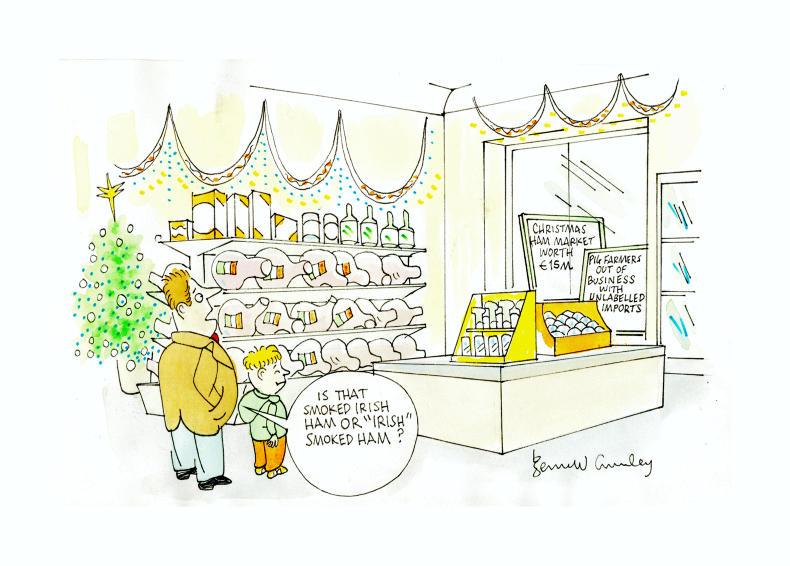Let’s start on a positive note. According to Bord Bia, the retail Christmas ham market of circa 2m kg was worth approximately €13m in 2015. Needless to say, that would suggest that Christmas is a fabulous time for Irish pig farmers and pig processors. Unfortunately, this is not the case.
It is a travesty that at this time of year, we as an industry still cannot confidently ask consumers to go anywhere except the retailers to buy their hams for fear that we would inadvertently send them to a Dutch or Danish supplier.
The labelling of products, despite some movement on country-of-origin labelling, is still providing little protection to consumers when it comes to purchasing the meat for one of the most anticipated dinners of the year. There are plenty of opportunists in the meat supply chain who view this as an ideal opportunity to mislead consumers and import meat which could easily be supplied by Irish processors. Consumers need to ask specific questions on origin if they want Irish meat not only in their Christmas hams but also at food service level. That Christmas dinner at the Christmas party, is it Irish? I sincerely doubt it.
EU prices
EU pig prices rose marginally in November, with the biggest jump achieved in the first week of December. Unfortunately, the Danish and German pig market came under serious pressure mid-December from Tönnies and Westfleisch, with resulting drops in these markets which was a very disappointing development for producers. If Irish prices remain stable for the rest of the year, although well up on last year’s level and technically in the black, farmers will only actually achieve 4c/kg over the 2015 price, which was disastrous.
However, all indications suggest that positive export trade will continue into 2017. The Chinese herd has continued to contract and exports increased this year by 104%. The main beneficiaries of these exports from a European point of view are Germany and Spain, with the US in the top three mix also. Irish farmers need to see the benefit of this in 2017.
Danish herd
The Danish herd has contracted in every quarter in 2016 and, although their breeding performance can often negate the falling sow population, the most recent survey shows declines across all areas of production. Despite this, Danish Crown has its eye on the prize with an investment planned for Shanghai with the production based on Danish raw material. They have other plans too, including raising the bar in terms of product offering, with organic and antibiotic-free goods to be available. It appears that there is a very attractive bonus (26c/kg) being paid on this antibiotic free product. This is the kind of money that makes anything possible. On top of this, Danish Crown in November recommended supplementary payments of €1.75m to the owners, which translate to approximately €0.13/kg of pigmeat and €0.11/kg on sows supplied by members.
The most recent Rabobank Chinese report, What to Watch, reads similar to an Irish what to watch – disease threats and environmental policy implementation. Although these challenges in China can help with our exports to the vital Chinese market, they can certainly cause problems on the home front too. A serious challenge is facing producers in 2017 with changes to nitrates regulations. The removal of the transitional arrangements will increase the cost of product by €1.60/pig or €6m for the whole industry.
Brexit to have major impact
Robert Malone of the IFA looks at the implications of Brexit
Representatives of the pig sector were present in the first all-Island dialogue session to discuss the implications of Brexit on the agri-food sector, hosted by Minister for Agriculture Michael Creed. The discussion on the pig industry covered a number of issues, including the short-term effects of the ongoing uncertainty, the sterling-euro exchange rate, and the longer-term challenges posed by potential changes in the areas of tariffs and trade, regulations and standards, and border controls and certification.
The movement of live pigs into Northern Ireland for slaughter and the live trade into mainland UK was highlighted and needs to be protected for the interests of farmers on both sides of the border. It is clear from this initial dialogue on Brexit that the agri-food sector must be involved at every stage of the EU-UK negotiations which will follow once Britain triggers article 50. The need for a Britain-Ireland trade deal was called for from the pig, and many other agri-food sectors, but the negotiation process will be conducted between Britain and the EU.
All stakeholders in the pig industry must have a united voice in ensuring the viability and potential growth of the pig industry is protected into the future in the highly complex Brexit negotiation process.


